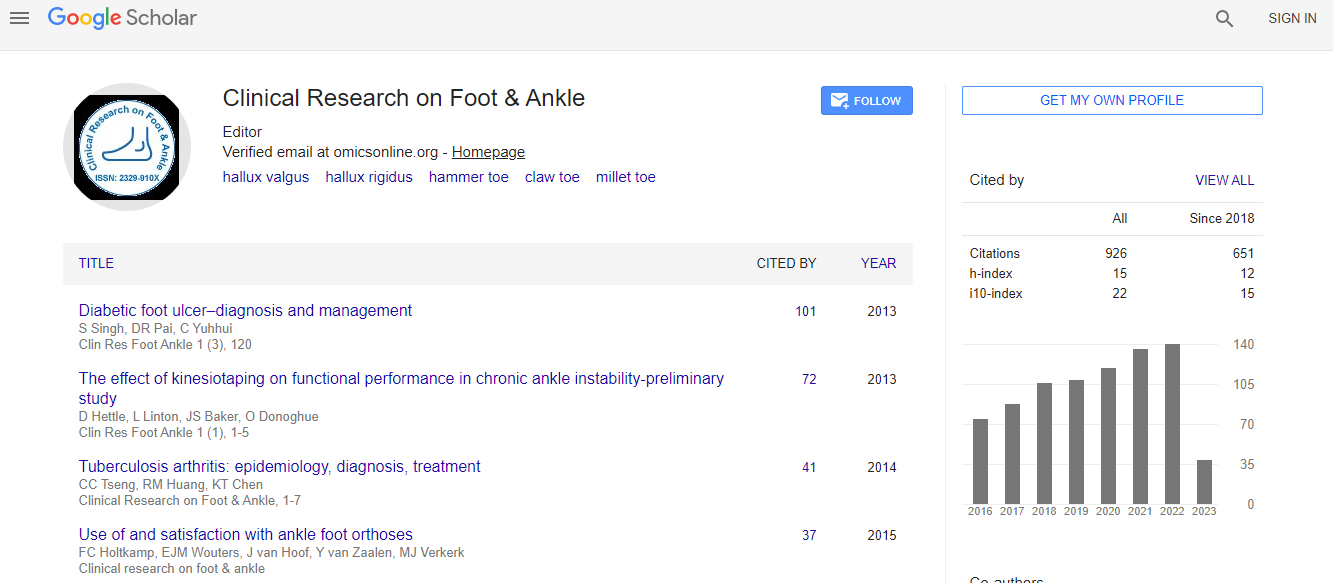Evaluation of the Therapeutic Effect of Extracorporeal Shockwave Therapy in Chronic Plantar Fasciitis
*Corresponding Author: Gernot Seppel, Department of Orthopedics, Sports Orthopedics Munich, Germany, Tel: +49 89 7558207, Email: seppel@ospmuenchen.deReceived Date: Nov 15, 2019 / Accepted Date: Dec 04, 2019 / Published Date: Dec 11, 2019
Citation: Hench M, Seppel G (2019) Evaluation of the Therapeutic Effect of Extracorporeal Shockwave Therapy in Chronic Plantar Fasciitis. Clin Res Foot Ankle 7: 292
Copyright: © 2019 Hench M, et al. This is an open-access article distributed under the terms of the Creative Commons Attribution License, which permits unrestricted use, distribution, and reproduction in any medium, provided the original author and source are credited.
Abstract
Background: Plantar fasciitis is a common pain syndrome of the foot associated with severe discomfort and often results in the patient’s limitation. Extracorporeal shock wave therapy (ESWT) is a widely used treatment
option which offers an alternative to other conventional methods. The objective of this study was to evaluate the effectiveness of ESWT in the treatment of plantar fasciitis. Material and methods: Thirty-two participants were enrolled in a prospective, randomized, placebo-controlled and double-blinded study. All participants were randomized into two groups. Therapy group received 3 sessions of focused ESWT in a weekly interval. Control group received placebo intervention with the same frequency. Outcomes of the follow-up were taken after the last treatment session and again in a 3-month follow-up. Evaluation of the treatment was achieved with the Visual Analog Scal (VAS) and Roles and Maudsley score.
Results: Treatment with ESWT provided superior results in evaluation with (VAS) and also with Roles and Maudsley score when compared with the placebo treatment. Decrease of pain in the first few steps in the morning was 29.9% after the last therapy and 63.2% in the 3-month follow-up in the therapy group. In the control group the decrease was 11% and 23.7% respectively. Decrease of pain in the normal daily activities was 29.0% after the last therapy and 63.0% in the 3-month follow-up. In the control group the decrease was 8.7% and 24.3% respectively. Satisfaction with the therapy results measured by Roles and Maudsley score improved by 28.1% after the last treatment and by 46.9% in the 3-month follow-up in the therapy group. In the control group the improvement was 6.3% and 18.8% respectively.
Discussion: Although the biologic effects of ESWT are not yet fully understood, the clinical evidence of its efficiency is being proved in a growing number of studies. It is not surprising that for this reason, ESWT is often
being compared to other treatment approaches such as corticosteroid injections. Another frequently discussed topic regarding the use of the ESWT in plantar fasciitis is the possible time-dependent cumulative effect.
Conclusion: Focused ESWT is an effective modality in the treatment of patients suffering from chronic plantar fasciitis in both short and long period.

 Spanish
Spanish  Chinese
Chinese  Russian
Russian  German
German  French
French  Japanese
Japanese  Portuguese
Portuguese  Hindi
Hindi 
